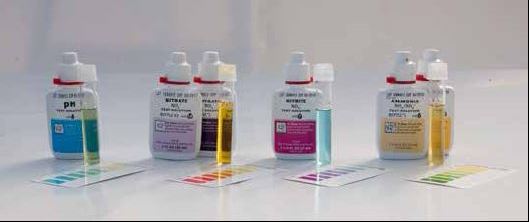3.6 WATER TESTING
In order to maintain good water quality in aquaponic units, it is recommended to perform water tests once per week to make sure all the parameters are within the optimum levels. However, mature and seasoned aquaponic units will have consistent water chemistry and do not need to be tested as often. In these cases water testing is only needed if a problem is suspected. In addition, daily health monitoring of the fish and the plants growing in the unit will indicate if something is wrong, although this method is not a substitution for water testing.
Access to simple water tests are strongly recommended for every aquaponic unit. Colour-coded freshwater test kits are readily available and easy to use (Figure 3.13). These kits include tests for pH, ammonia, nitrite, nitrate, GH, and KH. Each test involves adding 5-10 drops of a reagent into 5 millilitres of aquaponic water; each test takes no more than five minutes to complete.
Other methods include digital pH or nitrate meters (relatively expensive and very accurate) or water test strips (cheapest and moderately accurate, Figure 3.14).

FIGURE 3.13 Freshwater test kit for pH, ammonia, nitrite and nitrate. Values are determined by comparing the test water colour with that of the reference card
ph
The most important tests to perform weekly are pH, nitrate, carbonate hardness and water temperature, because these results will indicate whether the system is in balance. The results should be recorded each week in a dedicated logbook so trends and changes can be monitored throughout growing seasons. Testing for ammonia and nitrite is also extremely helpful in order to diagnose problems in the unit, especially in new units or if an increase in fish mortality raises toxicity concerns in an ongoing system. Although they are not essential for weekly monitoring in established units, they can provide very strong indicators of how well

FIGURE 3.14 Colour-coded water quality test strips
the bacteria are converting the fish waste and the health of the biofilter. Testing for ammonia and nitrate are the first action if any problems are noticed with the fish or plants.